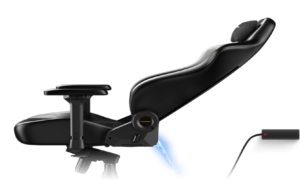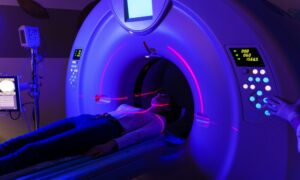Art and technology have always danced a delicate tango, but in the age of Artificial Intelligence (AI), this relationship is evolving into an electrifying masterpiece. Welcome to a world where pixels meet brushstrokes, and algorithms entwine with colors on canvas, as we dive deep into the captivating intersection of AI and visual arts. Brace yourself for an exhilarating journey through the corridors of creativity, witnessing how machines are revolutionizing the art world like never before!
Introduction to AI in the Art World
Artificial Intelligence (AI) has been transforming various industries, and the art world is no exception. In recent years, there has been an increase in the use of AI technology in creating and analyzing visual arts. This has sparked debates among artists, critics, and art enthusiasts on the impact of this integration and its potential role in revolutionizing the art world.
But what exactly is AI? In simple terms, it refers to machines that are programmed to mimic human intelligence by learning from data inputs and making decisions based on that information. This may include tasks such as image recognition, language processing, or decision-making.
The use of AI in the visual arts can be traced back to the 1950s when computer-generated images were first used as an experimental medium for artistic expression. However, it wasn’t until recent advancements in deep learning algorithms that AI technology became more sophisticated and capable of producing more complex visual artworks.
One of the most prominent ways in which AI is being utilized in the art world is through generative adversarial networks (GANs). GANs involve two neural networks – a generator and a discriminator – competing against each other to produce realistic images. The generator creates an image while the discriminator evaluates its quality and provides feedback for improvement. Through this process, GANs can generate original works of art based on existing images fed into their system.
Aside from creating new artworks, AI also plays a significant role in enhancing traditional methods of production for artists. For example, many artists now use apps or software that utilize machine learning algorithms to assist them with rendering techniques or suggesting color palettes.
Furthermore, AI technology has also made it possible for experts to analyze artworks at a faster rate than ever before. Through object recognition algorithms, computers can identify patterns and features within paintings or sculptures that may go unnoticed by human observers. This allows for deeper insights into an artist’s technique or style and assists with the authentication process.
How AI is being used in Visual Arts
The world of art has always been characterized by creativity, expression, and subjective interpretation. However, with the advancement of technology, specifically Artificial Intelligence (AI), there has been a noticeable shift in the way artists create and audiences experience visual arts.
One of the key ways AI is being used in visual arts is through machine learning algorithms. These algorithms are trained on vast amounts of data and can analyze images to identify patterns, colors, and styles. This allows them to generate new images that mimic human-created works or create entirely novel pieces. One notable example is “The Next Rembrandt” project which used data from Rembrandt’s paintings to train an algorithm to produce an original portrait that resembled his style. This fusion of human creativity and technological capability blurs the lines between what we consider as traditional art and what machines can produce.
Furthermore, AI is also being used in image processing for tasks such as color correction or enhancing resolution. This improves the quality of digital reproductions of artworks and makes them more accessible for virtual exhibitions or online catalogs. It also allows for restoration of damaged or deteriorating artworks without altering their original aesthetics.
In addition to creating and improving artworks themselves, AI is also revolutionizing how people interact with visual arts. Some museums have started incorporating AI-powered chatbots to provide guided tours or answer visitors’ questions about exhibits. These chatbots use natural language processing to understand inquiries in multiple languages, making it easier for international visitors to engage with exhibited works without language barriers.
Moreover, some artists are experimenting with interactive installations using AI-controlled sensors that react based on viewers’ movements or interactions. These installations allow for a personalized experience where each interaction creates a unique outcome. This combines traditional artistic techniques with modern technology to push boundaries and challenge viewers’ perceptions.
The Different Types of AI Art: Generative, Machine Learning, and More
There is no doubt that Artificial Intelligence (AI) has greatly impacted the visual arts world. With its ability to learn, adapt, and create, AI has opened up a whole new realm of possibilities for artists and art enthusiasts. As AI technology continues to advance, we are seeing more and more types of AI art emerge. In this section, we will explore some of the most intriguing forms of AI art – including generative art, machine learning art, and more.
1. Generative Art:
Generative art is a type of computer-generated art that involves using algorithms or rules to produce unique visual outputs. This type of AI art challenges traditional notions of authorship as the artist creates the framework for the artwork, but the final piece is generated by the algorithm itself. The artwork evolves and changes with each iteration, making it impossible to replicate exactly.
2. Machine Learning Art:
Machine learning refers to algorithms that can learn from data and improve over time without explicit programming instructions. In machine learning art, the algorithm uses training data such as images or text to generate new compositions or patterns based on what it has learned. This type of AI art often blurs the line between human creativity and artificial intelligence.
3. Natural Language Processing Art:
Natural Language Processing (NLP) is an area within AI that focuses on processing and understanding human language. In NLP art, algorithms are used to analyze text or speech inputs and produce visual outputs in response. This form of AI allows us to see how machines interpret language in visual form.
4. Neural Network Art:
Neural networks are computing systems modeled after the structure of our brains and have been widely used in image recognition tasks for many years now. With neural network-based deep learning techniques gaining popularity in recent years, they have also made their way into creating artworks. They work by analyzing large datasets captured through digital cameras or other devices, and producing images composed by mimicking various artistic styles as defined in the data.
5. Robotics Art:
Robotics art is a type of AI art that involves using robots to create physical works of art. These robots are programmed with AI algorithms, allowing them to interact with their environment and produce unique artworks. This form of AI art challenges our traditional notion of creating art as it is the robot, not the human, who holds control over the final outcome.
Examples of Famous AI Artworks
In recent years, Artificial Intelligence (AI) has been making waves in the art world, with AI-powered tools and algorithms being used to create unique and innovative artworks. These AI-generated artworks have caught the attention of art lovers and critics alike, igniting discussions about the role of technology in shaping the future of visual arts.
To better understand how AI is revolutionizing the art world, let’s take a closer look at some examples of famous AI artworks:
1. “The Next Rembrandt” by The Next Rembrandt Project
This groundbreaking project involved using deep learning algorithms to analyze all 346 paintings by Dutch master Rembrandt. Based on this analysis, a new portrait was created that resembled an authentic Rembrandt painting in style and composition.
2. “A.I.Robots Self-Portrait” by Ai-Da
Ai-Da is a humanoid robot developed by Engineered Arts Ltd., designed to sketch portraits using algorithmic rules and data input from cameras and sensors. In 2019, she became the first robot artist to hold her own exhibition at Oxford University’s St John’s College.
3. “Memories Of Passersby I Have Met Once” by Mario Klingemann
This artwork is part of Klingemann’s series titled “Neural Memories,” which uses Generative Adversarial Networks (GANs) to create constantly changing digital portraits based on millions of images scraped from social media platforms.
4. “Portrait Of Edmond de Belamy” by Obvious
In October 2018, an auction house made history when it sold an AI-generated portrait for $432,500 – far exceeding its original estimate of $7,000-$10,000. This portrait was created by Obvious using GANs trained on 15th-century Flemish portraits.
5. “Inceptionism Series” by Google DeepDream
Google’s DeepDream project uses artificial neural networks to generate images that are a surreal blend of recognizable elements. This resulted in visually stunning and often bizarre pieces, such as “The Elephant in the Room” and “Zuckerberg’s Secret Dream.”
Criticisms and Debate Surrounding AI Art
As with any new and emerging technology, the use of artificial intelligence (AI) in creating visual art has sparked various criticisms and debates among artists, art critics, and the general public. Many have raised concerns about the impact of AI on traditional artistic practices, questioning whether it can truly be considered as art or if it undermines the value of human creativity.
One of the main criticisms surrounding AI art is that it lacks emotion and originality. Unlike human artists who are influenced by their unique experiences and emotions, AI operates based on algorithms programmed by humans. This raises questions about whether a machine can truly create something original or if it is merely mimicking existing styles and techniques.
Moreover, some argue that using AI in art production takes away job opportunities from human artists, adding to concerns about automation replacing jobs in various industries. The fear of losing creative control over their work also worries many traditional artists who see AI as a threat to their livelihood.
On another note, there are also debates around the ethical implications of using AI in creating artworks. As machines learn from data fed into them by their creators, there have been cases where biases have been reflected in the generated works. This raises questions about diversity and representation in AI-generated art pieces.
Despite these criticisms and debates surrounding AI art, there are also those who view its incorporation into the visual arts world positively. Proponents argue that with advances in technology come new forms of artistic expression that challenge traditional notions of what constitutes as “art”. They see AI as a tool for expanding creative possibilities rather than replacing human artists.
In fact, some contemporary artists have fully embraced this technology and incorporate it into their practice seamlessly. These practitioners use algorithms not only to generate artwork but also as a medium for interaction between humans and machines.
Benefits and Challenges of Using AI in the Art World
Advancements in technology have revolutionized various industries, and the art world is no exception. Artificial Intelligence (AI) has emerged as a powerful tool for artists, galleries, museums, and collectors to enhance their creative output and decision-making processes. However, with all its benefits, the integration of AI into the art world also brings about several challenges that cannot be overlooked.
Here are some of the benefits and challenges of using AI in the art world:
1. Enhancing creativity: One of the most significant advantages of using AI in the arts is its ability to enhance artists’ creativity. With tools such as Generative Adversarial Networks (GANs), artists can train machines to produce unique artworks based on specific styles or techniques. This allows them to explore new avenues of expression and push boundaries that were previously restricted by human capabilities.
2. Cost-effective production: AI tools like deep learning algorithms enable artists to create high-quality artwork at a fraction of the time it would take a human artist. This makes production more cost-effective for both artists and galleries.
3 . Personalization: The use of AI also provides opportunities for personalized artwork creation. Artists can incorporate data points from individuals or groups into their creations, making them more relatable to their audience.
4 . Curating collections: Museums and galleries face overwhelming challenges when curating exhibitions due to large collections of artworks. Here is where AI comes in – it can analyze vast amounts of data quickly, making it easier for professionals to select works that align with certain themes or styles.
Despite these remarkable benefits, many challenges arise from integrating AI into the art world:
1 . Ethics: One major concern surrounding AI is its potential bias towards certain groups or demographics when creating works. It raises ethical questions about whether an artificially intelligent system should make decisions without human intervention.
2 . Ownership disputes: As seen with digital art pieces sold as Non-Fungible Tokens (NFTs), AI-generated artworks raise issues of ownership and authenticity. It is challenging to determine who owns the rights to an artwork created by a machine.
3 . Limiting human creativity: The use of AI in art may also limit the organic, unpredictable aspect of human creativity. With machines producing artworks based on predetermined algorithms, there is a risk of losing the unique touch and emotional depth that humans bring to their creations.
The Future of AI and Visual Arts: Possibilities and Limitations
The future of AI and visual arts is a topic that has been generating significant buzz in the art world. With advancements in technology and AI, there has been a growing interest in exploring the intersection between artificial intelligence and traditional forms of visual arts. While many artists and experts believe that AI has the potential to transform the way we create, experience, and appreciate art, others have raised concerns about its limitations.
Possibilities:
One of the most exciting possibilities of incorporating AI into visual arts is its potential to enhance creativity. With machine learning algorithms, AI can analyze vast amounts of data and generate new ideas or combinations that humans may not have thought of before. This opens up a whole new realm of artistic exploration, pushing artists to think outside their usual boundaries and come up with innovative concepts.
Furthermore, the use of AI can also speed up the creative process. With access to an extensive database of images, colors, textures, and styles from different eras and cultures, artists can quickly experiment with various elements until they find one that resonates with them. This can help them save time on tedious tasks like research or preliminary sketches.
Additionally, incorporating AI into visual arts also brings forth opportunities for collaboration between humans and machines. Artists can use AI as a tool to assist them in realizing their creative vision while still maintaining control over the final output.
Limitations:
Despite its possibilities, there are some limitations to using AI in visual arts that need to be considered.
Firstly, many critics argue that while machines may be able to replicate human-like creativity through algorithms and data analysis techniques; they lack emotional connection or consciousness when creating something. As such, it raises questions about whether artwork created by AI can truly hold any meaning or convey emotion as human-made art does.
Another limitation is our reliance on technology for creating art. As more artists turn towards using AI as a means for producing work, the danger lies in losing true artistic skills such as drawing, painting, or sculpting. This raises concerns about the impact it may have on future generations of artists and their artistic abilities.
Interview with an Artist Using AI in Their Work
The use of artificial intelligence (AI) has gained significant attention in the world of visual arts. Artists are pushing the boundaries and incorporating AI into their creative processes, resulting in stunning and thought-provoking works of art. To gain a deeper understanding of this intersection between AI and the art world, I had the opportunity to interview a prominent artist who utilizes AI in their work.
Ella Zhang is a digital artist known for her unique blend of traditional techniques with groundbreaking technology. Her latest series, “Exploring Reality,” features intricate abstract paintings that were created using an AI algorithm developed by her team. As we sat down to discuss her work and the role of AI in it, Ella shared her insights on how this technology has revolutionized not only her art but also the entire art industry.
When asked about her initial interest in integrating AI into her artwork, Ella explained that she has always been fascinated by advancements in technology and its impact on society. She saw immense potential in harnessing machine learning algorithms to create something truly unique that would challenge traditional notions of art-making.
Ella’s process involves feeding thousands of images into an AI model that then generates visuals based on patterns it recognizes. She then takes these generated images and incorporates them into her artwork along with traditional painting techniques such as acrylics or watercolors. The result is a mesmerizing combination where human expression meets machine precision.
Talking about any ethical concerns regarding creating art with an algorithm, Ella believes that as long as there is human input involved at some stage, it can still be considered authentic art. In fact, she argues that using AI allows artists to explore new territories and push their creativity beyond what they could achieve solely through traditional methods.
Conclusion
The use of AI technology in the visual arts has opened up new possibilities and challenges for artists, pushing the boundaries of creativity and raising questions about the role of humans in art. As we delve deeper into this revolutionary intersection, it is important to embrace and explore these advancements while also being mindful of their potential impact on our society and traditional artistic processes. Ultimately, this collaboration between human imagination and AI technology has the potential to revolutionize not just the art world but our understanding of what it means to be creative. We are excited to see where this journey will take us.



































